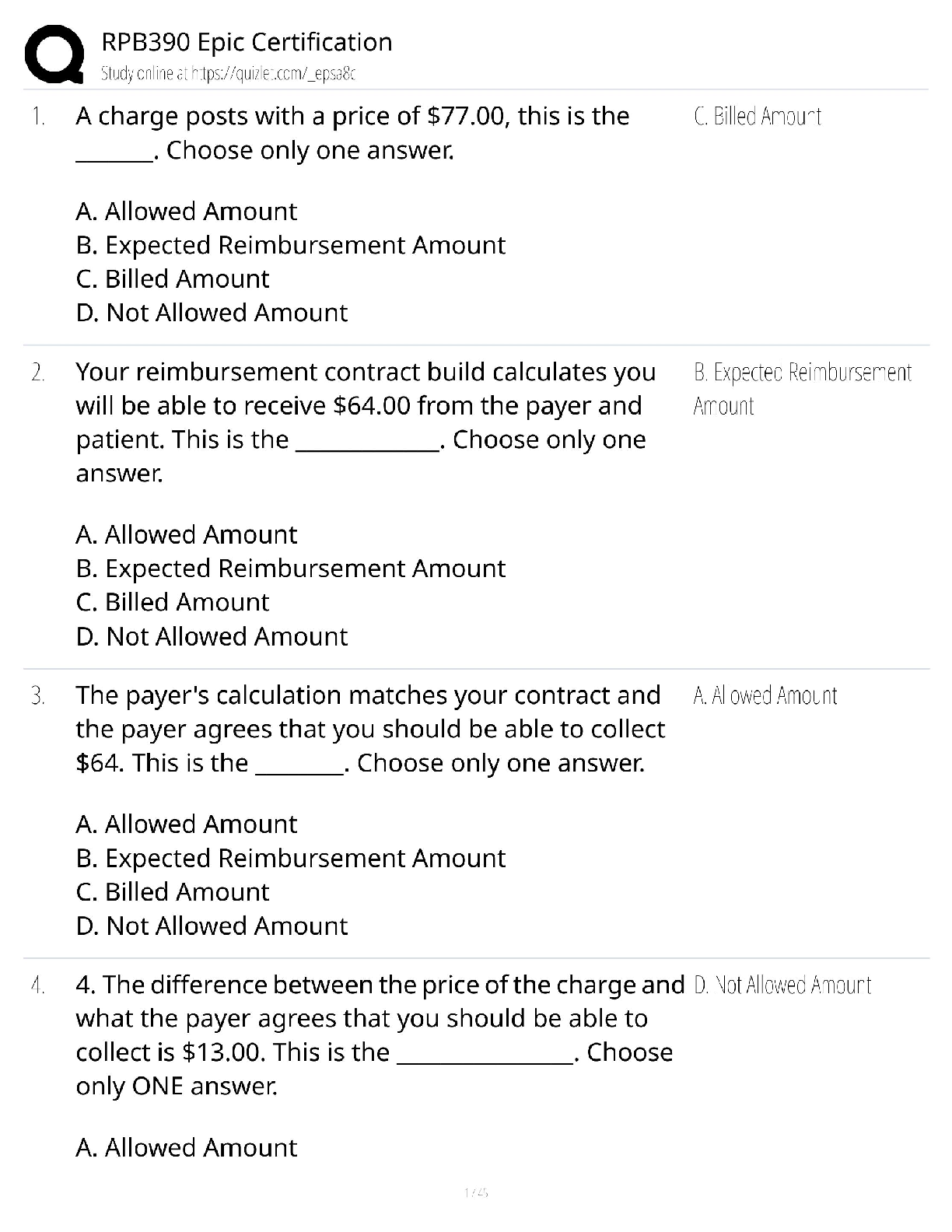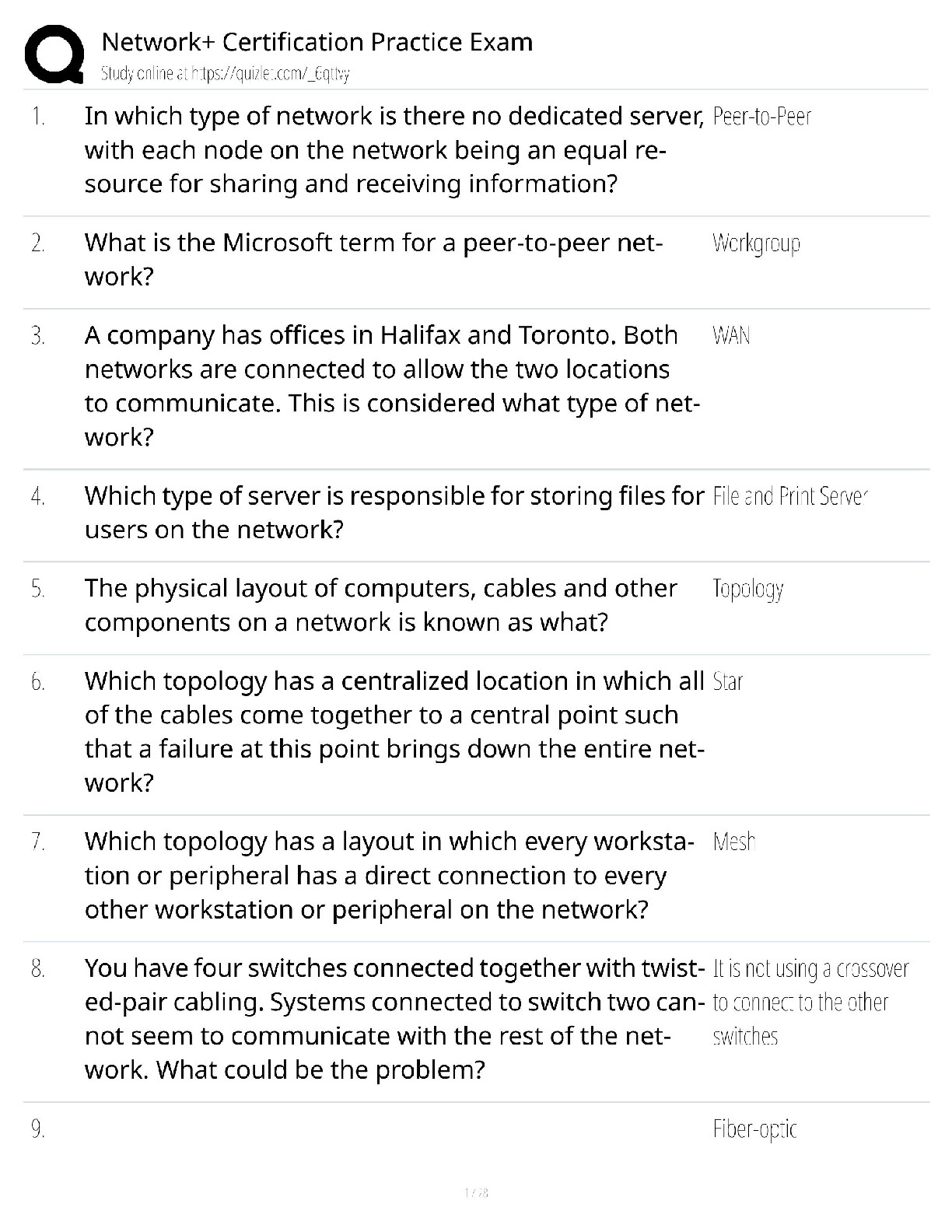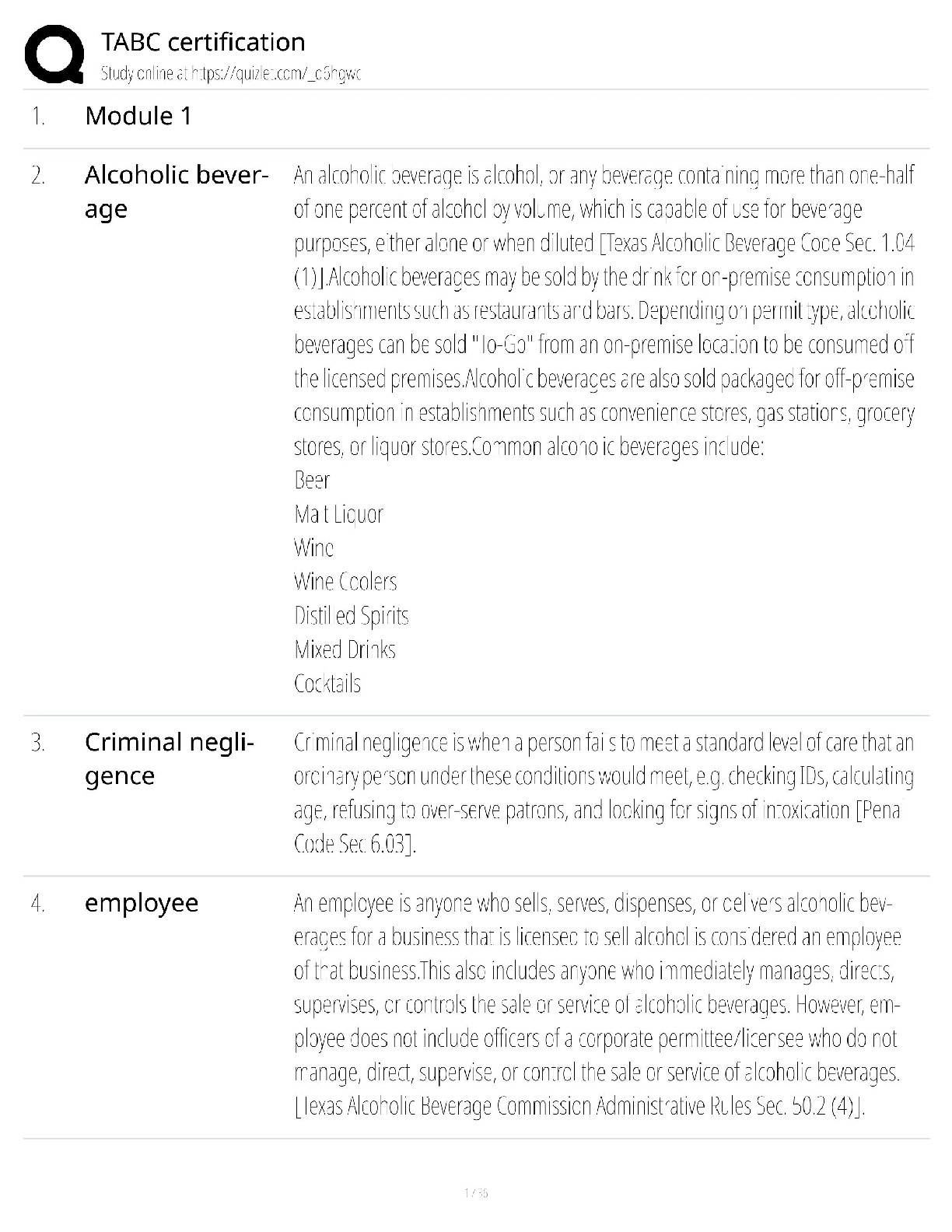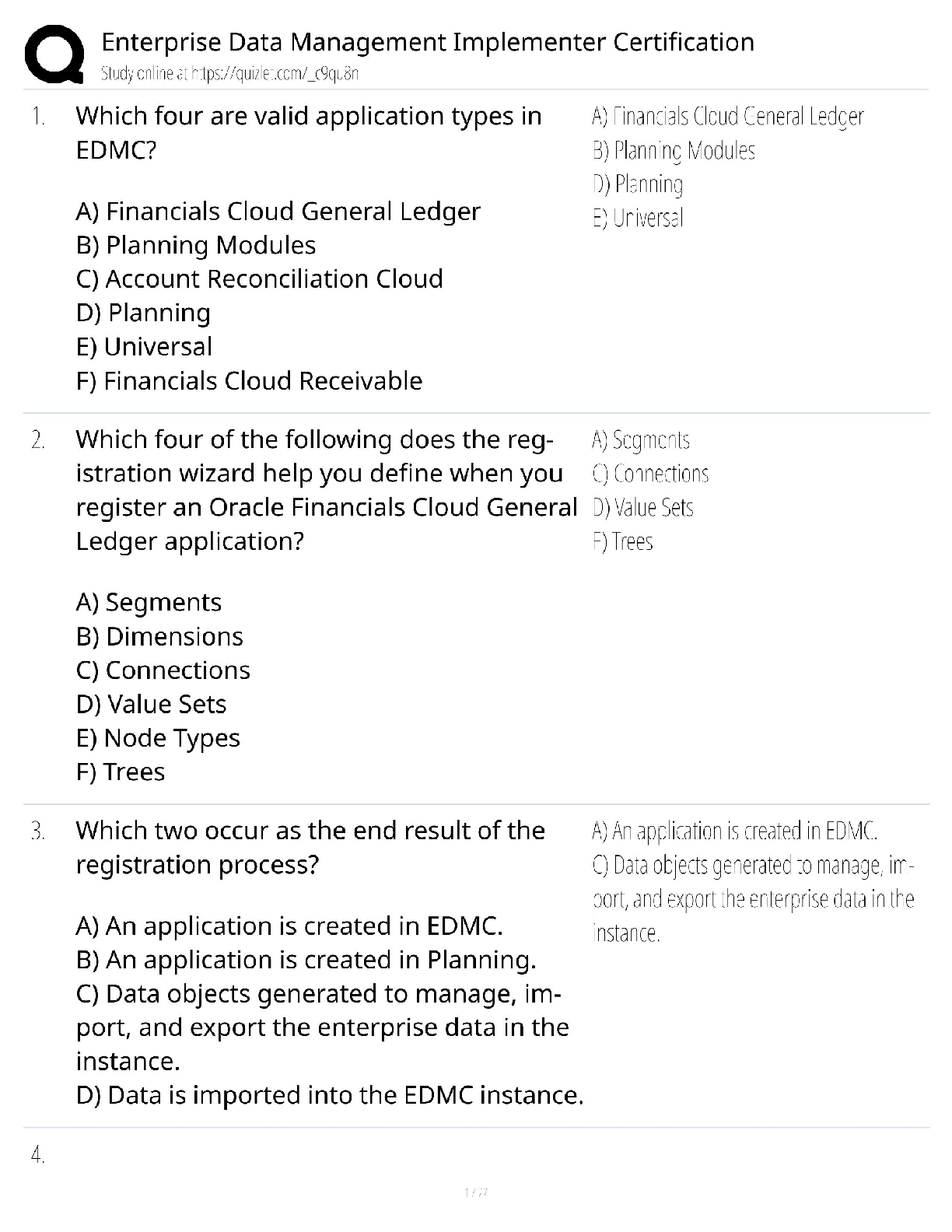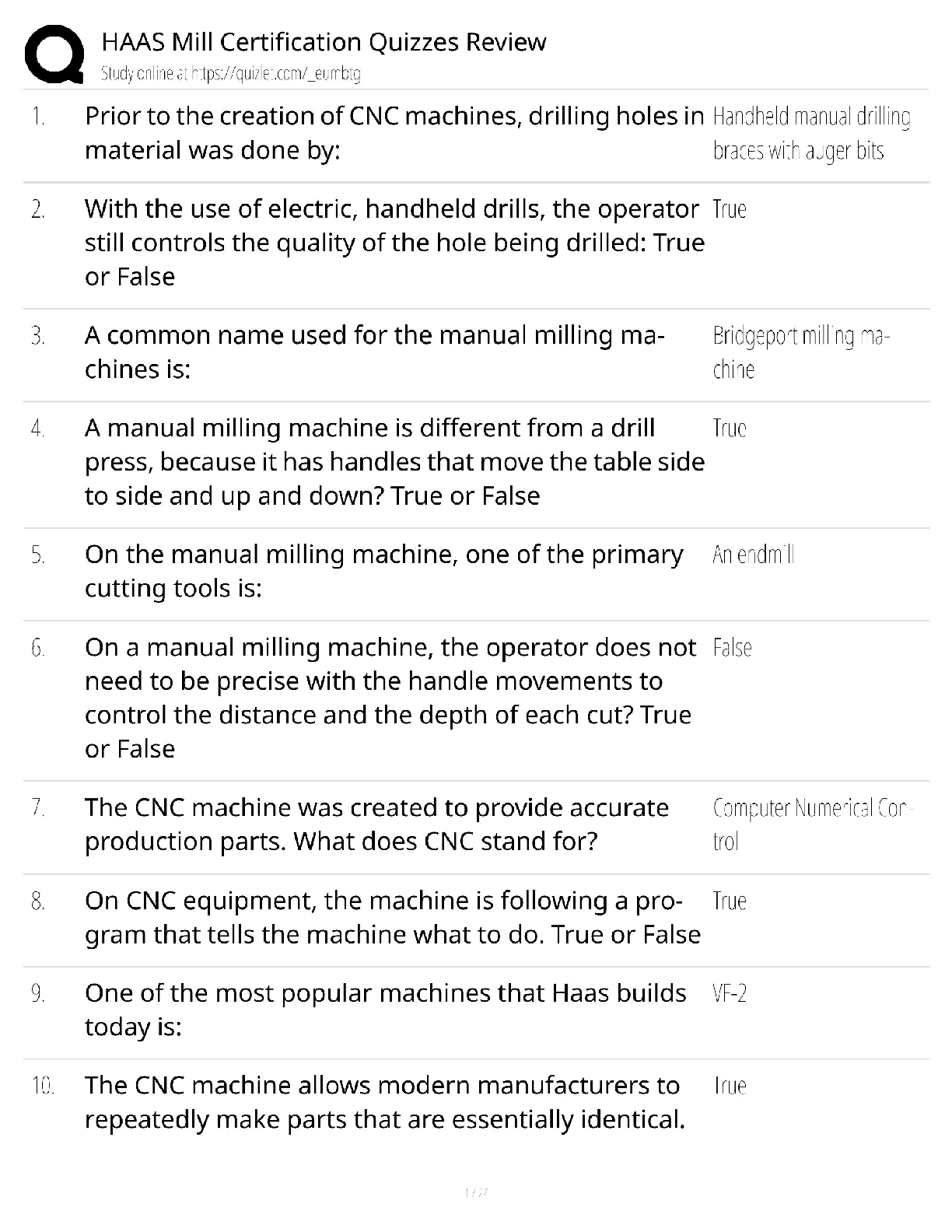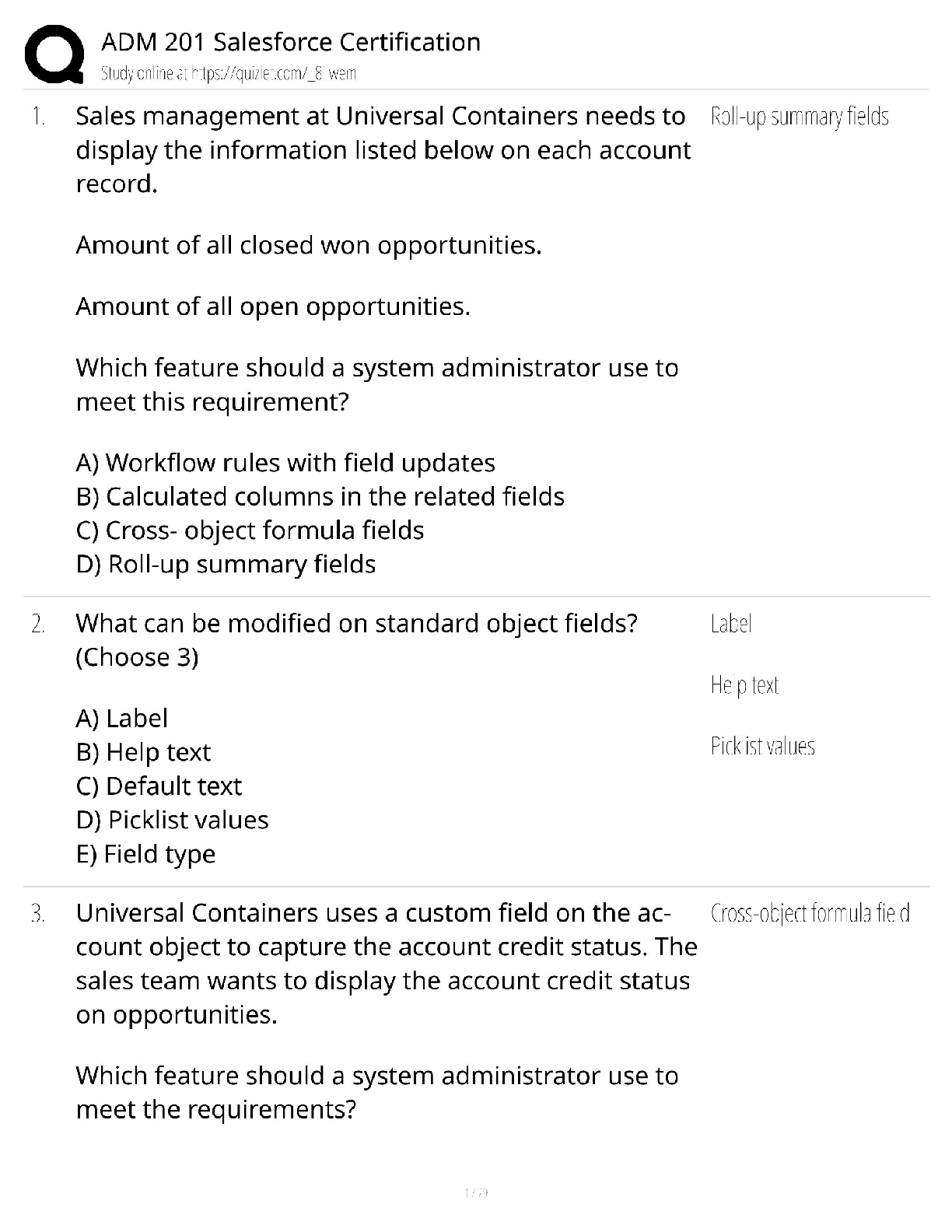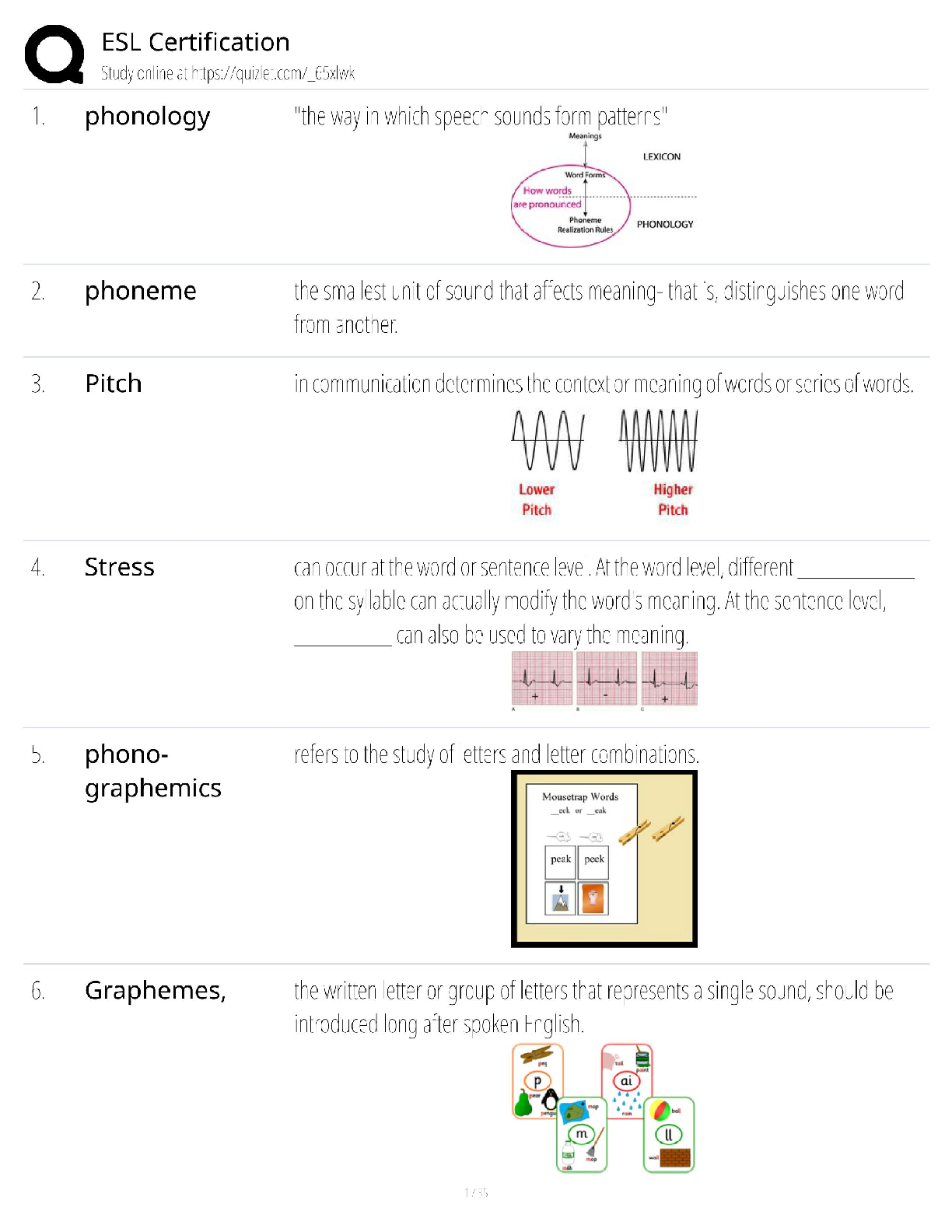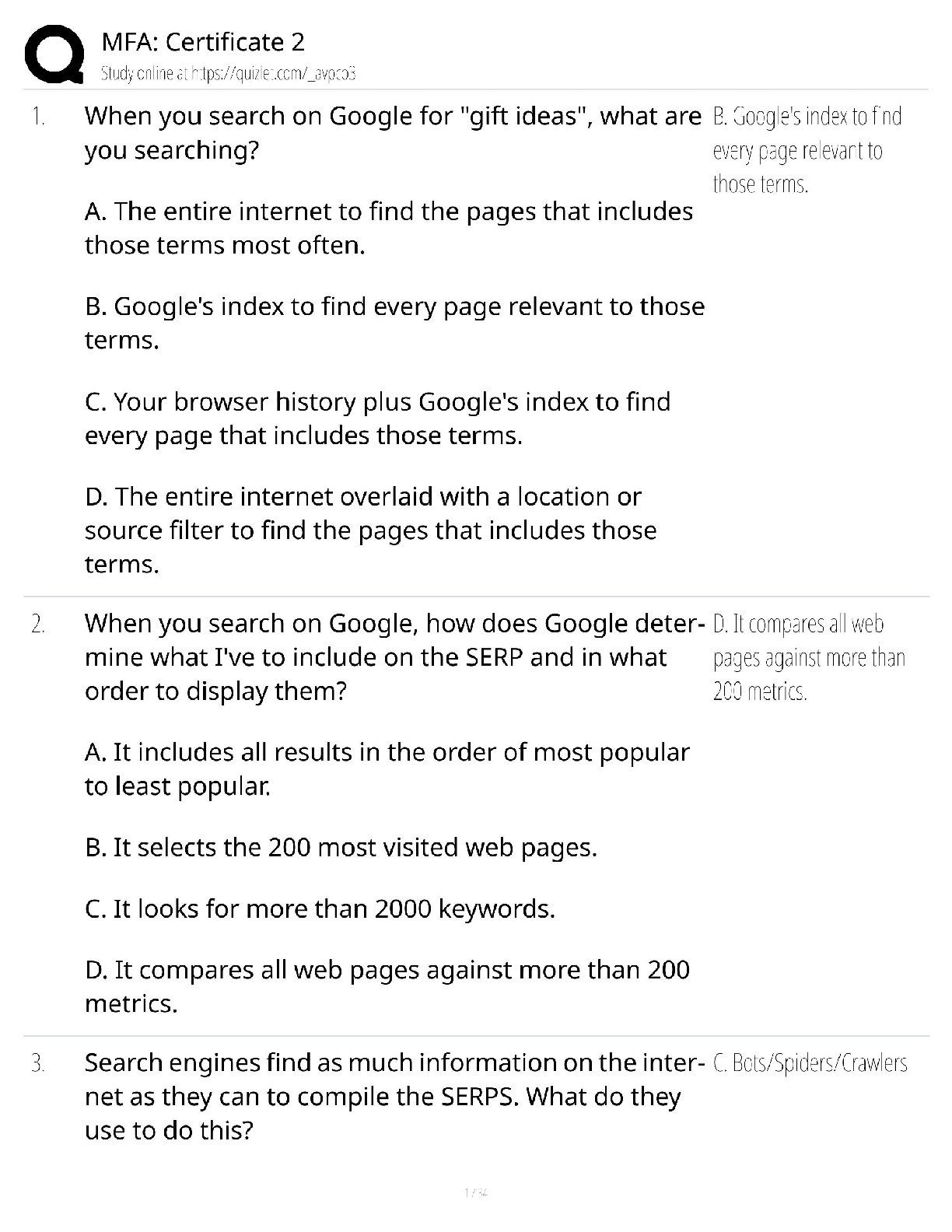Finance > QUESTIONS & ANSWERS > CFA Alternative Investments. Questions with accurate answers. Graded A+ (All)
CFA Alternative Investments. Questions with accurate answers. Graded A+
Document Content and Description Below
CFA Alternative Investments. Questions with accurate answers. Graded A+ What is a payoff equivalent of a merger strategy? - ✔✔A typical merger strategy involved longing the target company and ... shorting the acquirer, with the net spread representing the payoff if merger is successful. If the merger fails, the prices revert to what they were prior to merger announcement, and the strategy experiences a loss in both long and short position. The merger strategy is thus equivalent to holding a riskless bond with a face value of the net spread (the payoff for a successful deal) and a short binary put option, which expires worthless if the merger succeeds but pays out the total amount of loss if the merger fails. What is a conditional linear risk factor model? - ✔✔A multivariate linear regression that represents how hedge fund returns changes with respect to a number of risk factors. The model can show whether the strategy's risk exposures that are insignificant during calm periods become significant during turbulent market periods. - Equity risk (SNP500): monthly total return of the S&P 500 Index, including dividends. - Interest rate risk (BOND): monthly return of the Bloomberg Barclays Corporate AA Intermediate Bond Index. - Currency risk (USD): monthly return of the US Dollar Index. - Commodity risk (CMDTY): monthly total return of the Goldman Sachs Commodity Index (GSCI). - Credit risk (CREDIT): difference between monthly seasoned Baa and Aaa corporate bond yields provided by Moody's. - Volatility risk (VIX): first-difference of the end-of-month value of the CBOE Volatility Index (VIX). The dummy variable is employed in the model since factors may have different influence during normal periods and financial crises. What is the preferred hedge fund strategy during non-trending or declining markets? - ✔✔Equity market neutral strategy. - EMN return profiles are steadier and less volatile than those of many other hedge strategy areas - EMN managers are often a preferred replacement for fixed-income managers during periods when fixed-income returns are unattractively low What are the short selling risks associated with convertible arbitrage? - ✔✔In a convertible arbitrage strategy, a fund buys the convertible bond and takes a short position in the underlying security. When short selling, shares must be located and borrowed; as a result, the stock owner may want his/her shares returned at a potentially inopportune time, such as during stock price run-ups or when supply for the stock is low or demand for the stock is high. This situation, particularly a short squeeze, can lead to substantial losses and a suddenly unbalanced exposure if borrowing the underlying equity shares becomes too difficult or too costly for the arbitrageur. What are credit issues risks associated with convertible arbitrage? - ✔✔Credit issues may complicate valuation since bonds have exposure to credit risk. When credit spreads widen or narrow, there would be a mismatch in the values of the stock and convertible bond positions that the convertible manager may or may not have attempted to hedge away. What is time decay risk associated with convertible arbitrage? - ✔✔The convertible bond arbitrage strategy can lose money due to time decay of the convertible bond's embedded call option during periods of reduced realized equity volatility and/or due to a general compression of market implied volatility levels. What are extreme market volatility risks associate with convertible arbitrage? - ✔✔Convertible arbitrage strategies have performed best when: - convertible issuance is high (implying a wider choice among convertible securities as well as downward price pressure and cheaper prices) - general market volatility levels are moderate - the liquidity to trade and adjust positions is sufficient Extreme market volatility typically implies heightened credit risks. Convertibles are naturally less-liquid securities, so convertible managers generally do not fare well during such periods. Because hedge funds have become the natural market makers for convertibles and typically face significant redemption pressures from investors during crises, the strategy may have further unattractive left-tail risk attributes during periods of market stress. What are the four ways to implement relative value volatility arbitrage strategy? - ✔✔1. Exchange-traded options. The maturity of such options typically extends to no more than two years. In terms of expiry, the longer-dated options will have more absolute exposure to volatility levels than shorter-dated options, but the shorter-dated options will exhibit more delta sensitivity to price changes. 2. OTC options. In this case, the tenor and strike prices of the options can be customized. The tenor of expiry dates can then be extended beyond what is available with exchange-traded options. 3. VIX futures or options on VIX futures as a way to more explicitly express a pure volatility view without the need for constant delta hedging of an equity put or call for isolating the volatility exposure. 4. Purchase an OTC volatility swap or a variance swap from a creditworthy counterparty. A volatility swap is a forward contract on future realized price volatility. Similarly, a variance swap is a forward contract on future realized price variance, where variance is the square of volatility. Both volatility and variance swaps provide "pure" exposure to volatility alone, unlike standardized options in which the volatility exposure depends on the price of the underlying asset and must be isolated and extracted via delta hedging. What are the advantages of a multi-strategy fund over a fund-of-funds? - ✔✔- Multi-strategy managers reallocate capital into different strategy areas more quickly and efficiently - The multi-strategy manager has full transparency and a better picture of the interactions of the different teams' portfolio risks - The multi-strategy manager can react faster to different real-time market impacts—for example, by rapidly increasing or decreasing leverage within different strategies depending upon the perceived riskiness of available opportunities. - The fees paid by investors in a multi-strategy fund can be structured in a number of ways, some of which can be very attractive when compared to the FoFs' added fee layering and netting risk attributes. - Conceptually, FoF investors always face netting risk, whereby they are responsible for paying performance fees due to winning underlying funds while suffering return drag from the performance of losing underlying funds. Even if the FoF's overall performance is flat or down, FoF investors must still pay incentive fees due to the managers of winning funds. What is an equity related hedge fund? - ✔✔Equity-related hedge fund strategies focus primarily on the equity markets, and the majority of their risk profiles involve equity-oriented risk. Within this equity-related bucket, long/short equity, dedicated short bias, and equity market neutral are the main strategies What is an event driven hedge fund? - ✔✔Event-driven hedge fund strategies focus on corporate events, such as governance events, mergers and acquisitions, bankruptcy, and other key events for corporations. The primary risk for these strategies is event risk, the possibility that an unexpected event will negatively affect a company or security. Unexpected events include unforeseen corporate reorganization, a failed merger, credit rating downgrades, or company bankruptcy. The most common event-driven hedge fund strategies are merger arbitrage and distressed securities What is a relative value hedge fund? - ✔✔Relative value hedge fund strategies focus on the relative valuation between two or more securities. These strategies are often exposed to credit and liquidity risks because the valuation differences from which these strategies seek to benefit often are due to differences in credit quality and/or liquidity across different securities. The two common relative value hedge fund strategies are fixed-income arbitrage and convertible bond arbitrage. What is an opportunistic hedge fund? - ✔✔Opportunistic hedge fund strategies take a top-down approach, focusing on a multi-asset (often macro-oriented) opportunity set. The risks for opportunistic hedge fund strategies depend on the opportunity set involved and can vary across time and asset classes. The two common opportunistic hedge fund strategies are global macro and managed futures. What is a specialist hedge fund? - ✔✔Specialist hedge fund strategies focus on special or niche opportunities that often require a specialized skill or knowledge of a specific market. These strategies can be exposed to unique risks that stem from particular market sectors, niche securities, and/or esoteric instruments. We will explore two specialist strategies in further detail: volatility strategies involving options and reinsurance strategies. What is a multi-manager hedge fund? - ✔✔Multi-manager hedge fund strategies focus on building a portfolio of diversified hedge fund strategies. Managers in this strategy bucket use their skills to combine diverse strategies and dynamically re-allocate among them over time. The two most common types of multi-manager hedge funds are multi-strategy funds and fund-of-funds What is the profile of a typical long short fund? - ✔✔Risk Profile and Liquidity - Diverse opportunities globally create a wide universe from which to create alpha through astute stock picking. - Diverse investment styles include value/growth, large cap/small cap, discretionary/quantitative, and industry specialized. - They typically have average exposures of 40%-60% net long, composed of gross exposures of 70%-90% long, vs. 20%-50% short, but they can vary widely. - Return profiles are typically aimed to achieve average annual returns roughly equivalent to a long-only approach but with a standard deviation 50% lower than a long-only approach. - Some managers use index-based short hedges to reduce market risk, but most search for single-name shorts for portfolio alpha and added absolute return. - Some managers are able to add alpha via market timing of portfolio beta tilt, but evidence suggests that most L/S managers do this poorly. - This strategy can typically be handled by both limited partner and mutual fund-type vehicles. Attractiveness: Liquid, diverse, with mark-to-market pricing driven by public market quotes; added short-side exposure typically reduces beta risk and provides an additional source of potential alpha and reduced portfolio volatility. Leverage Usage Variable: The more market-neutral or quantitative the strategy approach, the more levered the strategy application tends to be to achieve a meaningful return profile. Benchmarking L/S equity benchmarks include HFRX and HFRI Equity Hedge Indices; Lipper TASS L/S Equity Hedge; Morningstar/CISDM Equity L/S Index; and Credit Suisse L/S Equity Index. What is the profile of a typical short-biased/short-seller fund? - ✔✔Risk Profile and Liquidity - Dedicated short sellers: They only trade with short-side exposure, although they may moderate short beta by also holding cash. - Short-biased managers: They are focused on good short-side stock picking, but they may moderate short beta with some value-oriented long exposure or index-oriented long exposure as well as cash. - Dedicated short sellers tend to be 60%-120% short at all times. Short-biased managers are typically around 30%-60% net short. The focus in both cases tends to be on single equity stock picking as opposed to index shorting. - Return goals are typically less than those for most other hedge fund strategies but with a negative correlation benefit. They are more volatile than a typical L/S equity hedge fund given short beta exposure. - Managers have some ability to add alpha via market timing of portfolio beta tilt, but it is difficult to do with consistency or added alpha. - This strategy is typically handled best in a limited partnership because of difficult operational aspects of short selling. Attractiveness: Liquid, negatively correlated alpha to that of most other strategies, with mark-to-market pricing from public prices. Historic returns have been lumpy and generally disappointing. Leverage Usage Low: There is typically sufficient natural volatility that short-selling managers do not need to add much leverage. Benchmarking Short-biased indexes include Eurekahedge Equity Short Bias Hedge Fund Index and Lipper TASS Dedicated Short-Bias Index. Some investors also compare short-biased funds' returns to the inverse of returns on related stock indexes. What are equity market neutral managers? - ✔✔Equity market-neutral (EMN) hedge fund strategies take opposite (i.e., long and short) positions in similar or related equities that have divergent valuations, and they also attempt to maintain a near net zero portfolio exposure to the market. EMN managers neutralize market risk by constructing their portfolios such that the expected portfolio beta is approximately equal to zero. Moreover, managers often choose to set the betas for sectors or industries as well as for such common risk factors as market size, price-to-earnings ratio, or book-to-market ratio, which are also equal to zero. What are the strategies implemented by equity market neutral managers? - ✔✔- pairs trading: capitalizes on the misalignment in prices of pairs of similar under- and overvalued equities. The expectation is the differential valuations or trading relationships will revert to their long-term mean values or their fundamentally-correct trading relationships, with the long position rising and the short position declining in value. - stub trading: entails buying and selling stock of a parent company and its subsidiaries, typically weighted by the percentage ownership of the parent company in the subsidiaries. Suppose parent company A owns 90% and 75% of subsidiaries B and C, respectively, and shares of A are determined to be overvalued while shares of B and C are deemed undervalued, all relative to their historical mean valuations. Then, for each share of A sold short, the EMN fund would buy 0.90 and 0.75 shares of B and C, respectively. - multi-class trading: capitalizes on misalignment in prices and involves buying and selling different classes of shares of the same company, such as voting and non-voting shares. What is the profile of equity market neutral hedge fund? - ✔✔Risk Profile and Liquidity - They have relatively modest return profiles, with portfolios aimed to be market neutral, and differing constraints to other factors and sector exposures are allowed. - They generally have high levels of diversification and liquidity and lower standard deviation of returns than many other strategies across normal market conditions. - Many different types of EMN managers exist, but many are purely quantitative managers (vs. discretionary managers). - Time horizons vary, but EMN strategies are typically oriented toward mean reversion, with shorter horizons than other strategies and more active trading. Because of often high leverage, EMN strategies typically do not meet regulatory leverage limits for mutual fund vehicles. So, limited partnerships are the preferred vehicle. Attractiveness: EMN strategies typically take advantage of idiosyncratic short-term mispricing between securities whose prices should otherwise be co-integrated. Their sources of return and alpha, unlike those of many other strategies, do not require accepting beta risk. So, EMN strategies are especially attractive during periods of market vulnerability and weakness. Leverage Usage High: As many beta risks (e.g., market, sector) are hedged away, it is generally deemed acceptable for EMN managers to apply higher levels of leverage while striving for meaningful return targets. Benchmarking Market-neutral indexes include HFRX and HFRI Equity Market Neutral Indices; Lipper TASS Equity Market Neutral Index; Morningstar/CISDM Equity Market Neutral Index; and Credit Suisse Equity Market Neutral Index. What are event-driven strategies? - ✔✔Event-driven (ED) hedge fund strategies take positions in corporate securities and derivatives that are attempting to profit from the outcome of mergers and acquisitions, bankruptcies, share issuances, buybacks, capital restructurings, re-organizations, accounting changes, and similar events. The most common ED strategies are merger arbitrage and distressed securities. What are the two main approaches in event-driven equity investing? - ✔✔soft-catalyst event-driven approach: Investments made proactively in anticipation of an event that has yet to occur. hard-catalyst event-driven approach: investments made in reaction to an already announced corporate event in which security prices related to the event have yet to fully converge. The hard approach is generally less volatile and less risky than soft-catalyst investing. What is the mechanics of a merger-arbitrage investment transaction? - ✔✔- In a cash-for-stock acquisition, the merger-arb manager may choose to buy just [Show More]
Last updated: 3 years ago
Preview 1 out of 29 pages

Buy this document to get the full access instantly
Instant Download Access after purchase
Buy NowInstant download
We Accept:

Also available in bundle (1)
Click Below to Access Bundle(s)

CFA level 1 bundle, alternative investments, Questions and study sets, 100% pass rate.
Comprehensive documents on CFA Level 1. graded A+. Download to score.
By bundleHub Solution guider 3 years ago
$20
6
Reviews( 0 )
$10.00
Can't find what you want? Try our AI powered Search
Document information
Connected school, study & course
About the document
Uploaded On
Aug 16, 2022
Number of pages
29
Written in
All
Seller

Reviews Received
Additional information
This document has been written for:
Uploaded
Aug 16, 2022
Downloads
0
Views
126













